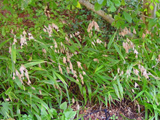Native Plants

Q. Who is Mr. Smarty Plants?
A: There are those who suspect Wildflower Center volunteers are the culpable and capable culprits. Yet, others think staff members play some, albeit small, role. You can torture us with your plant questions, but we will never reveal the Green Guru's secret identity.
Did you know you can access the Native Plant Information Network with your web-enabled smartphone?
Ask Mr. Smarty Plants is a free service provided by the staff and volunteers at the Lady Bird Johnson Wildflower Center.

rate this answer
Wednesday - April 29, 2009
From: Cincinnati, OH
Region: Midwest
Topic: Erosion Control
Title: Plants for controlling erosion on a cleared slope in Ohio
Answered by: Nan Hampton
QUESTION:
I live in Cincinnati, OH. BP owns a pipeline which runs thru part of my property. They clear out all the large trees every few years, so that it is visible from the air. Our area is surrounded by Mt. Airy forest and is heavily wooded, other than the cleared area. Our property is sloped, rather steeply beginning about 10' behind our above ground pool. Over the last 9 years, the top of our yard has begun to erode, exposing large roots from the surrounding trees. BP will do nothing to correct this, and they said we cannot plant any large trees to help keep the yard from eroding (I believe this is caused from the ground clearing). They said we can plant anything that is not more than 5' high and will not obscure an aerial view of the pipeline. My question is this: are there any plants, shrubs, evergreens, ground cover, etc. that would be helpful in anchoring the ground? We do not have the financial ability to hire an engineer to install a retaining wall. We did have 9 cubic yards of dirt put down last summer, and we had nice new grass coming up in the fall. but now this spring, it is only about half grass and half mud. we put down more seed and are trying some expanding pellets to help keep the seeds from sitting on top of the mud. But our concern mainly is the erosion control at the top of the hill. Any recommendations, links, or advice you have would be greatly appreciated. Thank you for your time.ANSWER:
This sounds like a good place for an erosion-control blanket to stabilize the erosion area so that the grass seeds can get a better chance to germinate and become established. The erosion-control fabric works by slowing the runoff water and allowing sediment to fall out rather than be washed away. Seeds are sown under the erosion-control material and grow up through the matting when they germinate. Underneath the matting the roots of the plants growing through the erosion-control material anchor the soil to stop the erosion. If you use erosion-control blankets made of biodegrable material, they will eventually disappear leaving the plants to control the problem. Native grasses are an excellent choice for controlling erosion because they develop extensive fibrous root systems that hold the soil in place. Seeds can be sown under an erosion control blanket or grass plugs can be planted through the blanket. After the grasses have begun to establish themselves and stabilize the area you can add other plants.I don't know which grasses you have tried, but here are some, along with a couple of sedges, that occur in or adjacent to Hamilton County, Ohio that I would recommend:
Elymus canadensis (Canada wildrye)
Schizachyrium scoparium (little bluestem)
Andropogon virginicus (broomsedge bluestem)
Carex blanda (eastern woodland sedge)
Carex pensylvanica (Pennsylvania sedge)
Chasmanthium latifolium (Inland sea oats)
Elymus villosus (hairy wildrye) and here is more information from Illinois Wildflowers.
Muhlenbergia schreberi (nimblewill)
Tridens flavus (purpletop tridens)
Here are some low-growing shrubs and perennial herbaceous plants that could be added with the grasses:
Ceanothus americanus (New Jersey tea)
Conoclinium coelestinum (blue mistflower)
Dasiphora fruticosa ssp. floribunda (shrubby cinquefoil)
Mitchella repens (partridgeberry)
Parthenocissus quinquefolia (Virginia creeper)
You can check for other possibilities by choosing Ohio from the map or the pulldown menu on our Recommended Species page.
More Erosion Control Questions
Grasses for Erosion control in Iowa
September 27, 2012 - We have a sloping yard in the midwest that gets 2-4 hours of sun during the warm weather. When we have large rainfalls, the water just pours down the slope causing a lot of erosion to the surrounding ...
view the full question and answer
Erosion prevention on shady Pennsylvania stream
July 28, 2011 - I'm looking for a few species to plant along a stream channel to help reduce erosion during heavy rains. The soil is moist and in full shade. Ferns and thorny bushes are the only current vegetation...
view the full question and answer
Erosion control after loss of large trees
July 19, 2007 - Our steep 40' river bank (NY near eastern shore of Lake Ontario - zone 4) has recently lost two 50' oaks, leaving enormous holes in the bank itself where they tore out. What should we do immediately...
view the full question and answer
Slope Erosion control for Fairview NC
August 19, 2012 - Please recommend plants to help with soil erosion on a slope. The soil is red clay and area gets full sun. The slope is approximately 12' x 12'. I live in Fairview, NC
view the full question and answer
Shade Shrubs for a NJ Slope
June 27, 2016 - I live in central NJ and have a 15' shaded slope behind my home with a creek on the bottom. The slope erodes a little every year and I want to plant native plants on the slope to stop the erosion. Wha...
view the full question and answer
| Support the Wildflower Center by Donating Online or Becoming a Member today. |

